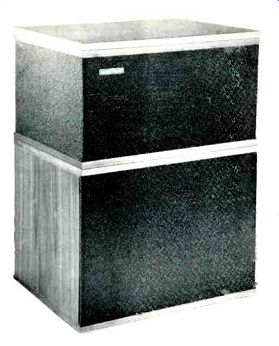
MANUFACTURER'S SPECIFICATIONS
Speaker Components: One 15-in. (38.1 cm) woofer, one 5-in. (12.7 cm) midrange, and one 13/4-in. (4.445 cm) special design tweeter.
Impedance: 8 ohms, nominal.
Frequency Response: 27 to 20,000 Hz ±3 dB; 40 to 18,000 Hz ±2 dB.
Dimensions: 32 1/2 in. (82.55 cm) H by 23 1/2 in. (59.7 cm) W by 18 in. (45.7 cm) D.
Weight: 105 lbs. (47.63 kg) each in shipping carton.
Price: $449.00 each.
The Duntech DL-15 is a three-way loudspeaker system. It is heavy (47.63 kg), and it is big (82 cm high, 59 cm wide, and 45 cm deep). It is one of those loudspeakers whose reproducing position in your home you should try to determine before you take delivery. The intent of this loudspeaker system is producing extremely high quality sound with no sacrifice of performance for ease of handling.
The enclosure is walnut finished and has black grille accenting the front and upper sides. A 381 mm (15 in.) woofer is used to cover the frequencies from below 40 Hz to a crossover of 350 Hz. A 127 mm (5 in.) midrange speaker covers the range from 350 Hz to 4 kHz, and a 445 mm (1 in.) tweeter takes over for frequencies above 4 kHz.
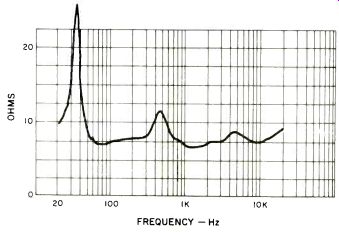
Fig. 1-Magnitude of impedance with tweeter control set flat.
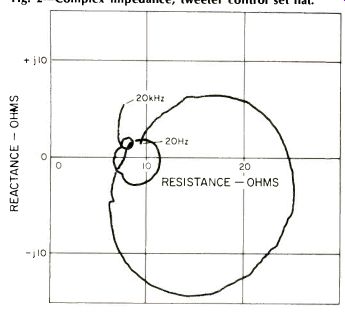
Fig. 2-Complex impedance, tweeter control set flat.
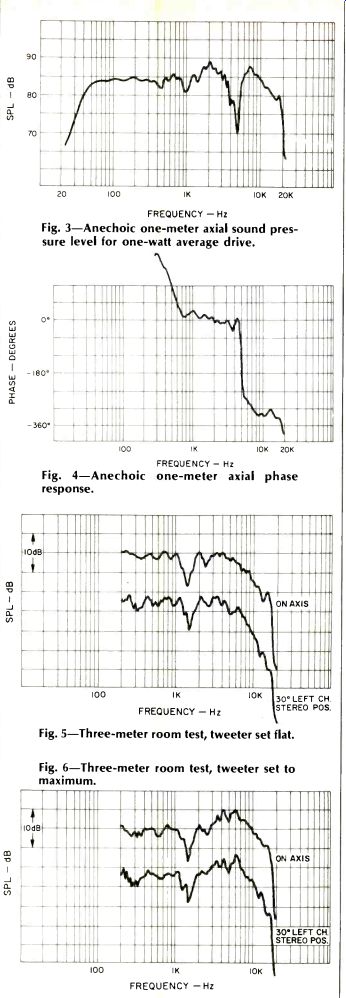
Fig. 3-Anechoic one-meter axial sound pressure level for one-watt average
drive.
Fig. 4-Anechoic response, one-meter axial phase
Fig. 5-Three-meter room test, tweeter set flat.
Fig. 6-Three-meter room test, tweeter set to maximum.
Speaker connection is made to well-marked terminals placed in a recessed cavity on the rear of the enclosure. Also mounted in this cavity is a system fuse holder for overload protection and a tweeter balance L-pad. A red dot is placed on the tweeter control place to indicate the position for flattest response, each speaker being individually calibrated.
Plastic angle brackets hold the upper grille in place and serve as edge trim on the upper front and sides. These brackets are cut off flat, leaving edges at the corners. In typical Laurel and Hardy fashion, I cut myself on one of the brackets when I grasped the enclosure to move it. My lack of grace notwithstanding, I hope that Duntech will smooth or remove these edges on subsequent units.
Duntech supplies a very thorough and readable instruction manual with each speaker. This covers both technical details and helpful suggestions on room placement for best sound. The DL-15 loudspeaker system carries a five-year, transferrable, full warranty against manufacturing defects.
Technical Measurements
The measured magnitude of loudspeaker impedance is shown in Fig. 1, and the corresponding complex plot is given in Fig. 2. The rear-mounted tweeter control was left in the factory preset flat position for both of these measurements.
Impedance variations are quite small and remain predominately resistive for frequencies above the characteristic bass resonance peak. This speaker should present no load problems to any quality power amplifier.
The one-meter axial anechoic frequency response at one watt average drive is shown in Fig. 3 for the amplitude of the sound pressure and in Fig. 4 for the phase. The tweeter control was set to the indicated flat position for these measurements. Bass response extends down to around 45 Hz, then rolls off smoothly. The unusual dip in response at 5 kHz, and its attendant phase change, warrants some discussion, particularly in view of the fact that Duntech measures the frequency response of each unit prior to shipment. Duntech's claim for their low frequency response is based on using a two-boundary measuring condition (wall and floor), which they believe more nearly approximates normal home listening conditions. Audio measures the response directly on the geometric center line of the speakers, with no "preferred" positions, and everybody gets the same treatment. It just happens that this is about the worst position for the Duntech. Moving the microphone a bit up to be aligned with the tweeter or down to be in front of the woofer substantially smooths the measured response, but the response shown in Figs. 3 and 4 is what the center-line measurement yields.
The acoustic transition between midrange and tweeter accounts for the dip in response at 4 to 5 kHz and nearly 360 degree shift in phase. The phase measurement was made with a time delay offset corresponding to the air path delay from midrange driver to microphone. The phase shift below 600 Hz is due to the woofer, which has an acoustic position behind the midrange driver and hence a longer time delay.
With the exception of the phase changes around 600 Hz and 5 kHz, the Duntech DL-15 is principally minimum phase.
Figure 5 shows the measured three-meter room response.
The DL-15 was placed on a carpeted floor and against a wall, as recommended by Duntech. A microphone position three meters from the front of the enclosure and one meter above the floor is used to simulate a normal listening position. The tweeter control was set to its indicated flat position. Two measurements are shown, one directly in front of the enclosure and the other angled 30 degrees for the Duntech in a normal left-channel stereo position; the plots are displaced 10 dB for clarity. The response is quite smooth throughout the frequency range but begins to drop above 7 kHz, though it extends smoothly to 18 kHz. (Editor's note: This high end drop, says Duntech, with distance was intentional. It is based on their contention that the same drop is evident with most musical instruments and the human voice due to a reduction in angular dispersion at frequencies higher than about 4 or 5 kHz.) In order to check the top end drop, the measurement was rerun with the tweeter control in its maximum position, with the results shown in Fig. 6. It appears that the tweeter control should be left in its flat position as a 6-kHz peak occurs when the control is placed in its maximum position.
If you want to pull the top end up for a more uniform direct source sound, an equalizer should be used which pre emphasizes the frequencies above 5 kHz. An octave band equalizer may do it, but a normal pre-amplifier tone control will not and should be left in the flat position.
The polar energy response is shown in Fig. 7 for horizontal dispersion and in Fig. 8 for vertical dispersion. This is a measurement of the total sound energy density for all frequencies equally weighted from 20 Hz to 20 kHz. The three curves are for the rear-mounted tweeter control in its minimum, flat, and maximum position.
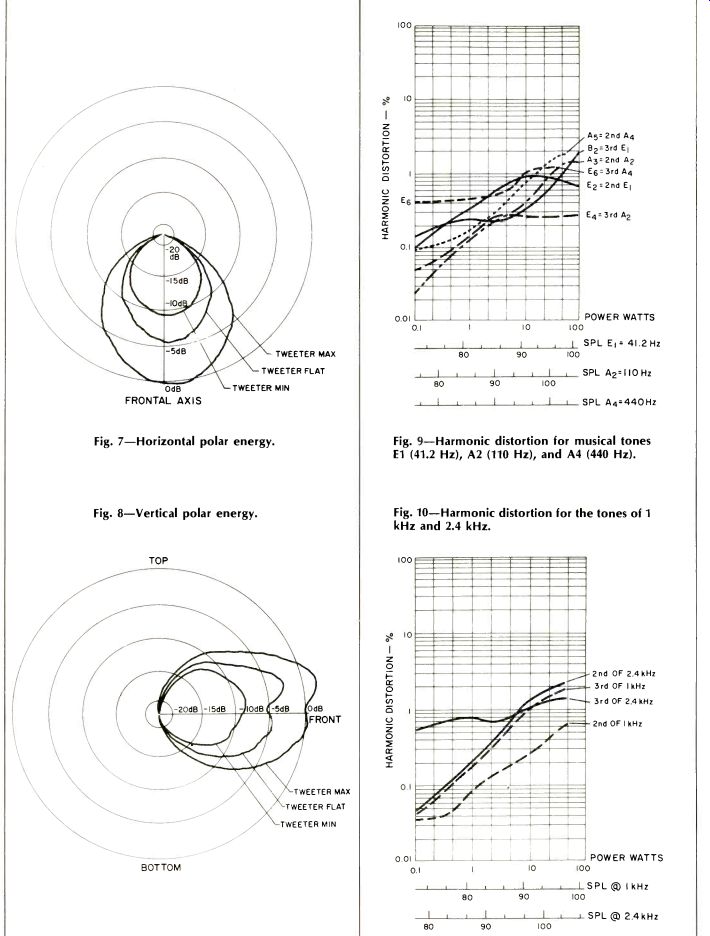
Fig. 7-Horizontal polar energy.
Fig. 8-Vertical polar energy.
Fig. 9-Harmonic distortion for musical tones E1 (41.2 Hz), A2 (110 Hz), and A4 (440 Hz).
Fig. 10-Harmonic distortion for the tones of 1 kHz and 2.4 kHz.
The horizontal polar pattern is quite symmetric with almost no left or right dominance of sound. The vertical polar pattern, particularly in the flat position, shows a mild upward dominance of launch angle for sound with a minor notch on axis. This verifies the axial frequency response measurement difficulty we encountered in the anechoic test. The room tests, shown in Figs. 5 and 6, have a microphone position above the enclosure's geometric axis and thus are made in the major vertical lobe of Fig. 8. This is why the 5-kHz notch did not show for an average room listening position. (Editor's note: Duntech points out that the smoothness of the polar plots is, in large part, due to the use of foam around the midrange and tweeter units. Used in this manner, says Duntech, the foam also prevents diffraction effects which take their toll on the sharpness of transients.
The success they achieved can be judged from the sharp peak in the energy-time plot shown in Fig. 12.) Harmonic distortion tor the musical tones E1 or 41 Hz, A2 or 110 Hz, and A4 or 440 Hz is shown in Fig. 9. The low bass (41 Hz) distortion, usually where most distortion occurs, is quite low, right up to the 100-watt level, where it is just reaching 2 per cent.
During the earlier listening test, it seemed to this reviewer that the upper midrange frequencies, particularly around 3 kHz, were reproduced with a mildly strained quality suggestive of nonlinear distortion. During later measurements on these speakers, we went looking for it with the aid of a spectrum analyzer and found that the midrange driver has difficulty handling the spectrum around 2.4 kHz. Figure 10 shows the second and third harmonic distortion for the frequencies of 1 kHz and 2.4 kHz. The fourth and higher order harmonics lie well below these levels.
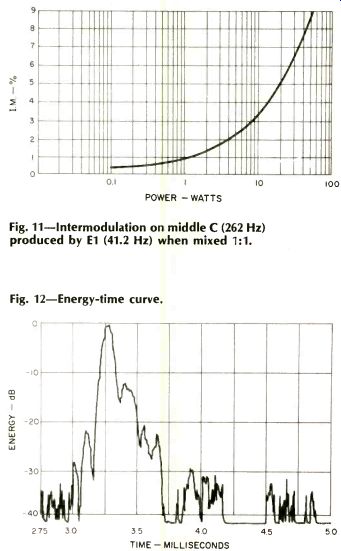
Fig. 11-Intermodulation on middle C (262 Hz) produced by E1 (41.2 Hz) when mixed 1:1.
Fig. 12-Energy-time curve.
The Duntech woofer crosses over at 350 Hz, which is approximately F above middle C. In order to check for woofer intermodulation, we used E1l or 41.2 Hz and middle C, 262 Hz, approximately one-half octave below the crossover frequency. These were mixed in equal ratio and the cross-modulation of C4 by E1 measured and the results are shown in Fig. 11. The nature of this intermodulation is principally amplitude modulation of C4 by El up to high levels, then an additional phase modulation occurs at the highest levels. At 40 watts average drive, for example, the peak-to-peak phase modulation is about 10 degrees and the peak-to-peak amplitude modulation is about 5 per cent.
The energy-time response, which is the logarithmic magnitude of the impulse response, is shown in Fig. 12 for the one-meter axial position. The anticipatory peaks at 3.0 and 3.1 millisecond are computer artifacts caused by the rapid phase change of the loudspeaker response at 5 kHz. The actual sound pressure level commences at 3.16 milliseconds and peaks accurately at 3.26 milliseconds, as shown here.
The tweeter and midrange start their separate impulse responses at the same time, but because the tweeter has peaked its arrival energy before the midrange unit, there is a residual response from the midrange driver extending to 3.7 milliseconds. Diffraction peaks occur at around 4.0 and 4.6 milliseconds, but they are minor. The first arrival at 3.26 milliseconds has a spectral dominance at around 8 kHz, and the spectral peak at 3.4 milliseconds is around 18 kHz. The spectral components at 3.6 milliseconds are principally 3 kHz and are due to the midrange driver.
Listening Test
In order to assess the listening quality of the DL-15s, they were mounted exactly as recommended by Duntech, flat against a wall and subtending an angle of 60 degrees relative to the listening position.
My overall impression of the reproduced sound quality is that the response is well balanced and extended, with good high and extreme low frequencies. The extra low bass seemed somewhat prominent, and a mild drop in bass level by preamplifier tone control was felt to help out a bit. I found that I wanted a mild high frequency pre-emphasis for some musical material, particularly vocals and brass.
In my opinion, the only detraction from otherwise superior reproduction is a touch of stridency in the midrange, from 1 kHz to 5 kHz, at high sound levels (above 95 dB SPL), which stands apart from the clear bass and extreme top end. This was particularly noticeable on vocals. In my earlier listening notes I commented that there is some distortion at around 3 kHz, which the technical measurement showed was at 2.4 kHz. I also sensed a moderate peak at 100 to 200 Hz in the response, which may be due to the flush wall placement of the enclosure.
Stereo imagery is good, both for lateralization and a sense of depth. There is, however, a change of timbre with listening position, and this results in a small amount of space wandering of center-positioned stereo images as one moves about the listening area.
I consider that the DL-15 has one of the most accurate reproductions of a piano which this reviewer has heard from commercial speakers thus far. The spectrum up through the octave above middle C is clean and free of audible peaks, and the 100 to 200 Hz "room bump" can be readily softened by tone control equalization.
The low bass is reproduced quite firmly with only the slightest evidence of bass hangover on percussion.
I found the DL-15 totally unforgiving of any substantial sound absorbing object near the front of the enclosure. The area immediately near the front of the enclosure must be clear of objects or the stereo illusion goes to pot.
The Duntechs need a good, big power amplifier if you like your sound loud; a Marantz Model 510 handles them quite well. And you need a good-sized living room to make use of the bass response which the speakers are capable of achieving. If you've got that, and some clean recorded material, you can sit back and enjoy some truly good sound with a pair of DL-15s.
-Richard C. Heyser
(adapted from Audio magazine, Aug. 1976)
Also see:
Dynaco A-35 Loudspeaker System (Jun. 1973)
= = = =